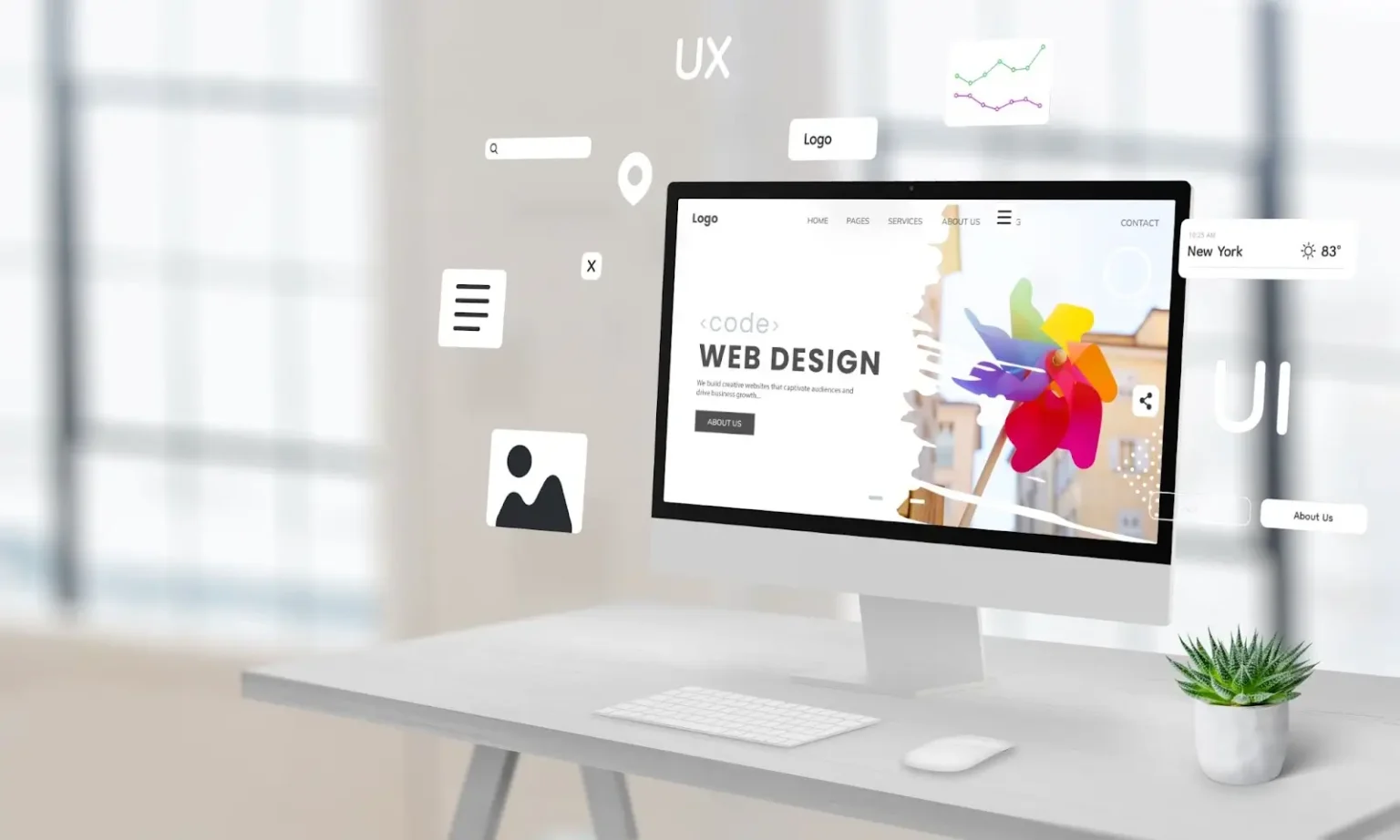The Importance of User Experience in Efficient Web Design Techniques
User experience (UX) functions as a keystone in efficient web design strategies. It forms just how individuals interact with a website, affecting their contentment and probability of returning. A well-designed UX can enhance engagement via intuitive navigating and responsive layouts. Nevertheless, overlooking these facets might bring about aggravation and enhanced bounce rates. Understanding the details of UX is necessary for designers aiming to produce compelling electronic experiences that reverberate with varied audiences. What aspects truly drive successful user involvement?
Recognizing User Experience and Its Effect On Design
User experience (UX) is typically perceived as a mere element of web design, it basically forms how customers engage with a web site. UX incorporates all aspects of the user's communication, including use, availability, and general satisfaction. A positive UX fosters interaction, motivating individuals to discover the site and return in the future. Alternatively, an adverse experience can result in stress, leading to high bounce prices and lost possibilities for conversion.
Style aspects like layout, navigation, and material company play essential roles fit this experience. Effective UX design expects user requirements and preferences, making certain that info is aesthetically enticing and conveniently available. Furthermore, recognizing user habits through analytics can supply beneficial understandings, educating design choices that boost use. Inevitably, an extensive understanding of UX allows developers to produce web sites that not just bring in customers but likewise advertise significant interactions that straighten with service objectives and user expectations.
Key Principles of Reliable User Experience
Effective user experience pivots on numerous essential concepts that improve web site capability and interaction. Intuitive navigation layout, receptive design essentials, and the importance of aesthetic pecking order are important components that add to a seamless communication in between customers and web material. Understanding these concepts permits developers to create more accessible and straightforward digital settings.
User-friendly Navigating Style
When users come across a web site, instinctive navigating design acts as a crucial entrance to their overall experience. Efficient navigation enables individuals to easily find the information they look for, boosting their interaction with the site. Trick principles consist of clear labeling, sensible organization, and constant positioning of navigation aspects. Tags need to be uncomplicated, permitting individuals to anticipate the material they will certainly discover. A well-structured pecking order helps individuals recognize the connection between various sections, directing them through the site flawlessly. Additionally, receptive menus and quickly available links add to a liquid experience across tools. By prioritizing user-friendly navigating, developers can considerably reduce user stress and increase engagement, eventually fostering a positive assumption of the web site and its content.
Responsive Design Basics
A well-structured navigation system normally causes the requirement for a responsive layout, which is necessary in today's varied digital landscape. A receptive layout warranties that websites function perfectly throughout different devices, consisting of desktop computers, smart devices, and tablets. This flexibility boosts user experience by permitting content to be quickly accessible and aesthetically meaningful, no matter display size. Trick concepts of receptive design consist of fluid grids, adaptable images, and media questions, which help with suitable viewing. Furthermore, focusing on touch-friendly elements enhances communication on mobile gadgets. By implementing a responsive design, designers can suit users' requirements, reduce bounce prices, and boost involvement. Ultimately, a well-executed receptive style cultivates a positive user experience, motivating visitors to discover the internet site further.
Visual Power Structure Importance
Visual hierarchy plays a vital duty in leading customers via an internet site, making certain that vital info captures their attention first. By tactically utilizing dimension, comparison, shade, and spacing, designers can produce a clear pathway for users to follow. Larger components typically attract the eye, indicating their value, while contrasting colors can highlight phone call to action. Furthermore, regular placement and grouping of associated material improve understanding, making navigating user-friendly. Reliable use aesthetic pecking order not only enhances functionality however additionally sustains the general visual of the site, promoting a positive user experience. When customers can quickly determine the most vital details, they are more probable to engage with the material, causing boosted complete satisfaction and interaction with the website.
The Function of Functionality in Web Design
Use plays a crucial function in web design, specifically via navigation simplicity and adherence to ease of access standards. Effective navigation enhances user contentment by permitting site visitors to locate details swiftly and intuitively. Conference access criteria guarantees that all users, regardless of their capacities, can properly communicate with the site.
Navigation Simplicity
Simplicity in navigation stands as a foundation of efficient web design, considerably affecting user experience. A structured navigating system allows users to find information quickly and with ease, minimizing frustration and enhancing fulfillment. Clear labeling and logical structure are essential components, assisting users effortlessly via the site. Redundant links or overly intricate menus can disorient individuals, leading to raised bounce rates. Furthermore, mobile responsiveness has to be considered, making sure navigation remains straightforward throughout gadgets. Decreasing and focusing on essential web pages mess better supports user involvement. Efficient navigation not just cultivates a positive experience but also urges users to discover the site extra extensively, inevitably resulting in greater conversion rates. Hereof, navigation simpleness works as an important consider the overall performance of web design approaches.
Ease of access Requirements
User interaction is greatly boosted when internet sites stick to accessibility requirements, guaranteeing that all users, no matter of their abilities, can browse and interact effectively. Compliance with these standards not just expands the target market however likewise enhances general user contentment. Obtainable layout integrates features such as text options for images, key-board navigating, and adequate color contrast, which promote usage by individuals with handicaps. Furthermore, applying these requirements can positively influence seo (SEO) by enhancing site structure and clearness. As web design evolves, focusing on ease of access comes to be necessary in cultivating a comprehensive digital setting. By embracing these standards, designers add to a more equitable internet, ultimately driving user commitment and engagement.
Value of Responsive Layout for User Interaction
As customers significantly accessibility sites with a range of gadgets, the importance of receptive layout ends up being extremely important for engaging individuals effectively. Receptive design assurances that a site adjusts effortlessly to different display dimensions, offering an ideal viewing experience no matter the tool used. This flexibility improves user interaction by facilitating simpler navigating and communication with material.
When individuals come across a site that is responsive, they are most my blog likely to remain longer, explore further, and return in the future. A properly designed responsive format minimizes the irritation often related to zooming and scrolling on smaller sized displays, thus lowering bounce prices. Furthermore, responsive design can favorably influence online search engine positions, as search engines prioritize mobile-friendly websites. In today's digital landscape, where mobile usage remains to rise, executing receptive style is not simply useful, yet necessary for keeping user involvement and assuring a positive experience across all gadgets.
Enhancing Load Times for Better User Complete Satisfaction

To boost lots times, internet developers must focus on enhancing pictures, leveraging browser caching, and reducing HTTP requests. Furthermore, utilizing Material Shipment Networks (CDNs) can accelerate material distribution by distributing it across different geographic places. Streamlining code, such as compressing CSS and JavaScript documents, better adds to much faster filling rates.
Eventually, a commitment to enhancing lots times not only improves user contentment however likewise reinforces brand commitment and enhances the possibility of repeat gos to. A swift, seamless experience is crucial for keeping customers and cultivating favorable interactions.
The Impact of Visual Pecking Order on User Communication
Visual pecking order functions as a vital element in guiding user communication on a web site. By organizing content in such a way that prioritizes information aesthetically, developers can affect how users involve and navigate with a website. This hierarchy is established through various style strategies, consisting of dimension, contrast, shade, and spacing. For circumstances, larger typefaces or bold colors accentuate important elements, such as telephone calls to activity or headlines, while suppressed colors and smaller sized typefaces can show subordinate information.
Effective aesthetic pecking order aids users rapidly recognize what is essential, minimizing cognitive lots and enhancing functionality. It enables user-friendly navigation, making it much easier for individuals to locate what they require without aggravation. As individuals connect with a website, a well-structured visual power structure fosters a much more enjoyable experience, ultimately leading to higher interaction and conversion prices. Developers have to prioritize these concepts to produce an user-centered and effective web environment.
Gauging User Experience: Tools and Techniques

Regularly Asked Concerns
Just How Can I Improve My Website's User Experience on a Spending plan?
To boost a website's user experience on a budget, one can maximize web page lots rate, streamline navigation, execute receptive layout, enhance material clarity, and gather user responses for continuous improvements, making certain a rewarding visitor experience.
What Prevail User Experience Errors to Stay Clear Of in Web Design?
Typical user experience errors in web design consist of chaotic designs, inadequate navigation, slow loading times, lack of mobile responsiveness, neglecting ease of access, irregular branding, and failing to focus on user responses - Website Design Agency. Each can substantially impede general site efficiency
How Commonly Should I Update My Site for Better User Experience?
Web sites need to be updated regularly, ideally every few months, to preserve suitable user experience. Regular updates assist address usability concerns, revitalize content, and adapt to altering user needs, making certain the website remains pertinent and engaging.

Can User Experience Impact SEO Rankings on My Site?
User experience can substantially affect SEO positions, as online search engine focus on sites that supply seamless navigation, fast loading times, and appealing content. A favorable user experience try this site can result in lower bounce prices and higher search visibility.
What Duty Does Ease Of Access Play in User Experience Design?
Access plays a crucial function in user experience layout by guaranteeing that all individuals, despite Recommended Site abilities, can connect and browse with a site effectively. This inclusivity boosts total contentment and engagement among varied individuals.
User experience (UX) is typically viewed as a mere element of web style, it fundamentally forms how customers interact with a web site. User interaction is greatly enhanced when web sites adhere to availability standards, making certain that all users, no matter of their capacities, can navigate and communicate effectively. Determining user experience (UX) is crucial for recognizing exactly how efficiently a website satisfies the requirements of its customers. In addition, functionality screening, where genuine users browse the website while observers note problems, offers straight responses on user experience. Usual user experience blunders in internet layout include cluttered layouts, poor navigating, slow packing times, absence of mobile responsiveness, overlooking availability, irregular branding, and stopping working to prioritize user comments.